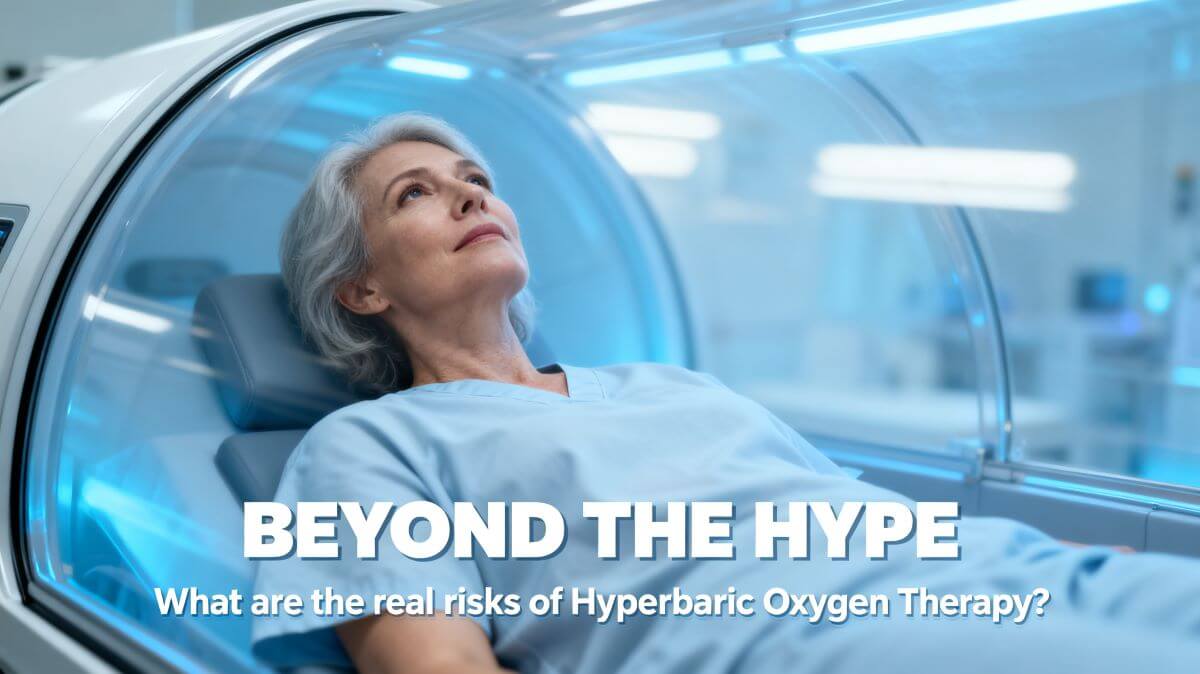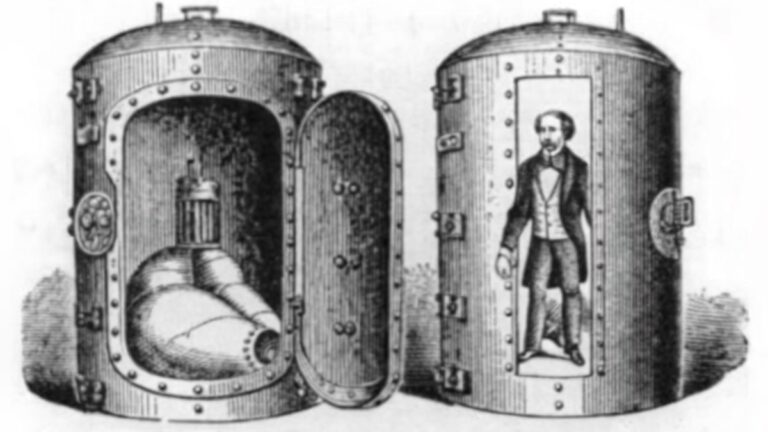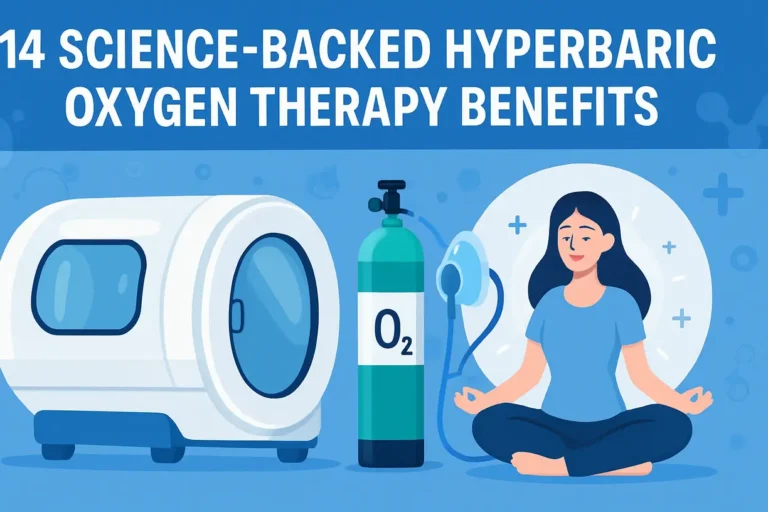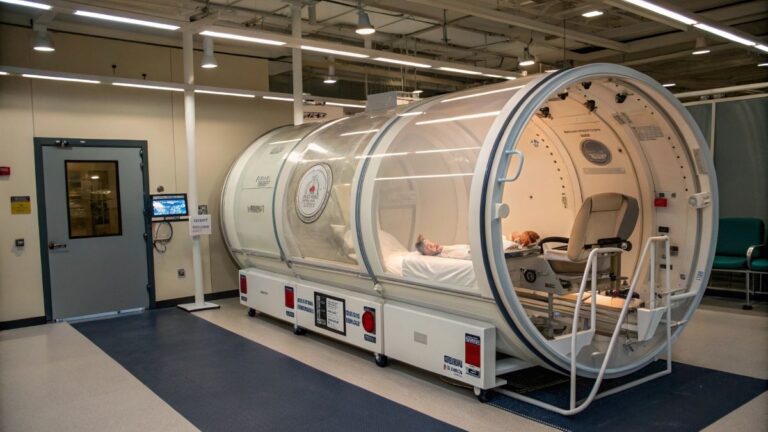What is Hyperbaric Oxygen Therapy (HBOT) and Is It Safe?
Hyperbaric oxygen therapy involves breathing pure oxygen while sitting or lying in a pressurized chamber. The air pressure inside is about 2-3 times higher than normal air pressure, which allows your lungs to gather more oxygen than would be possible breathing pure oxygen at normal air pressure [1].
Doctors commonly prescribe HBOT for conditions like non-healing wounds, severe anemia, carbon monoxide poisoning, and radiation injuries from cancer treatment. The therapy works by flooding your tissues with oxygen, promoting healing and fighting certain types of infections [2].
“Is this treatment actually safe?” If that question is running through your mind, you’re not alone. The good news: HBOT is a well-established medical treatment with an excellent safety record when performed by trained professionals. According to the Undersea and Hyperbaric Medical Society, serious complications occur in fewer than 1 in 10,000 treatments [3].
Like any medical procedure, HBOT does carry some potential risks and side effects. Most are mild and temporary. Understanding what to expect can help you feel more prepared and confident about your treatment.
The Most Common Side Effects of HBOT (And How to Manage Them)
1. Ear and Sinus Discomfort
The most frequent side effect patients experience is middle ear barotrauma = discomfort caused by pressure differences between the inside and outside of your eardrum. About 2% of patients experience some degree of ear discomfort during treatment [4].
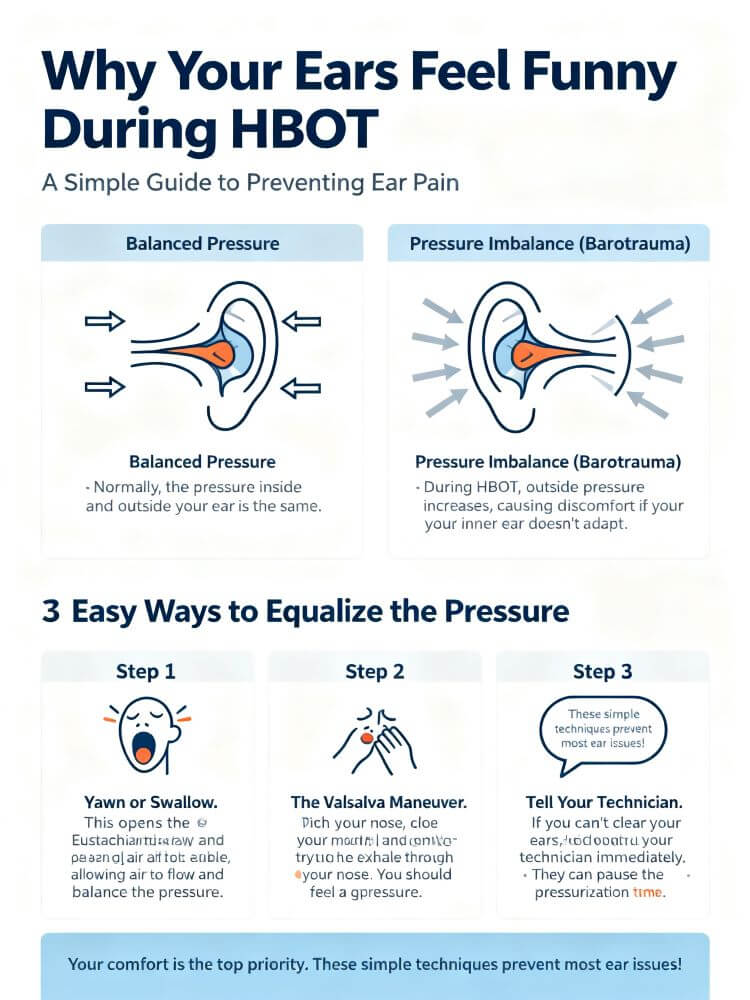
You might feel:
- Ear pain or pressure
- A sensation of fullness in your ears
- Difficulty hearing
- Sinus pressure or pain
These sensations occur because the increased pressure in the chamber pushes on your eardrum. Your body needs time to equalize the pressure on both sides of the eardrum through your Eustachian tubes = the small passages connecting your middle ear to your throat.
Prevention and management strategies:
- Swallow frequently during pressure changes
- Yawn deliberately to open your Eustachian tubes
- Try the Valsalva maneuver: gently pinch your nose closed and blow softly with your mouth closed
- Move your jaw side to side
- Alert your technician immediately if you experience pain
Your HBOT technician will coach you through these techniques and can slow or stop pressurization if needed. Most patients master pressure equalization within their first few sessions.
2. Temporary Vision Changes
Approximately 20-40% of patients receiving multiple HBOT sessions experience temporary nearsightedness, technically called myopic shift [5].
This happens because the high oxygen levels can temporarily change the shape of your eye’s lens.
What should you expect?
Objects at a distance may appear blurrier than usual, while close-up vision might actually improve. These changes typically begin after 20-30 treatments and reverse within 6-8 weeks after completing therapy [6].
(Ed. note: Most patients don’t need new glasses during this temporary period, though some find inexpensive reading glasses helpful for distance vision if the change is significant.)
3. Feeling Tired or Lightheaded Post-Treatment
Some patients report feeling unusually tired after their HBOT session, while others experience mild lightheadedness when standing up after treatment. These effects typically last 10-30 minutes and occur because your body is adjusting from the high-oxygen environment back to normal air [7].
Simple management tips:
- Sit for a few minutes before standing after your session
- Have a light snack and water available for after treatment
- Plan for a brief rest period before driving or returning to activities
Less Common, But Important, Potential Side Effects
4. Claustrophobia and Anxiety in the Chamber
“What if I panic inside the chamber?”
This concern affects about 15% of patients to some degree [8]. Modern hyperbaric chambers often feature clear acrylic walls, allowing you to see out in all directions.
You’ll have constant communication with your technician through an intercom system, and most facilities provide entertainment options like TV or music.
Coping strategies that help:
- Practice relaxation breathing before your session
- Bring calming music or an audiobook
- Focus on the temporary nature of each session (typically 90-120 minutes)
- Discuss anti-anxiety medication with your doctor if needed
5. Oxygen Toxicity
In rare cases, breathing high concentrations of oxygen can affect your central nervous system or lungs. Central nervous system oxygen toxicity occurs in approximately 1-3 per 10,000 treatments [9].
Warning signs include:
- Muscle twitching, especially facial muscles
- Nausea or dizziness
- Vision or hearing changes
- Seizures (extremely rare)
Treatment protocols are specifically designed to prevent oxygen toxicity by limiting session length and using “air breaks” = brief periods of breathing regular air during treatment. Your medical team monitors you throughout each session.
6. Lung Damage (Pulmonary Barotrauma)
This rare complication can occur if air becomes trapped in the lungs and expands during decompression. The most important prevention measure: never hold your breath during pressure changes, especially during decompression [10].
Always breathe normally and continuously throughout your treatment. If you have any lung conditions like COPD or asthma, discuss them thoroughly with your doctor before starting HBOT.
7. Low Blood Sugar (Hypoglycemia) in Diabetic Patients
HBOT can lower blood glucose levels by 25-50 mg/dL in diabetic patients [11].
This effect occurs because the therapy may increase insulin sensitivity and glucose uptake by tissues.
If you have diabetes:
- Check your blood sugar before and after each session
- Bring glucose tablets or juice to your appointment
- Eat a meal 1-2 hours before treatment
- Work with your doctor to adjust insulin doses if needed
8. Dental Pain (Dental Barotrauma)
Pressure changes can trap small air bubbles under dental work, causing sharp pain during pressurization or decompression. This affects less than 1% of patients but can be quite uncomfortable when it occurs [12].
Tell your HBOT team if you have:
- Recent dental work
- Loose fillings or crowns
- Untreated cavities
- Any dental pain during treatment
9. Temporary Digestive Issues
Some patients experience what researchers call a “cleansing reaction” = temporary changes in gut bacteria due to the high-oxygen environment. Symptoms may include:
- Mild flu-like feelings
- Stomach discomfort
- Constipation or diarrhea
- Bloating
These symptoms typically appear within 1-36 hours after treatment and resolve on their own [13]. Staying hydrated and eating probiotic-rich foods may help.
What Are You Feeling?
Use this quick guide to understand common sensations during HBOT. This is for informational purposes only and is not a substitute for medical advice.
Action Plan
Who Might Be at a Higher Risk for Side Effects?
Certain conditions increase your risk of experiencing side effects:
- History of ear surgeries or chronic ear problems – May have difficulty equalizing pressure
- Emphysema or other lung diseases – Higher risk of lung barotrauma
- Recent dental procedures – Increased chance of dental pain
- Uncontrolled high fever – Can lower seizure threshold
- Recent chemotherapy with certain drugs (bleomycin, doxorubicin) – May increase lung toxicity risk
- Untreated pneumothorax (collapsed lung) – Absolute contraindication for HBOT
- Pregnancy – Relative contraindication; used only in life-threatening situations
- Severe heart failure – May not tolerate pressure changes well
What to Discuss with Your Doctor Before Starting Treatment
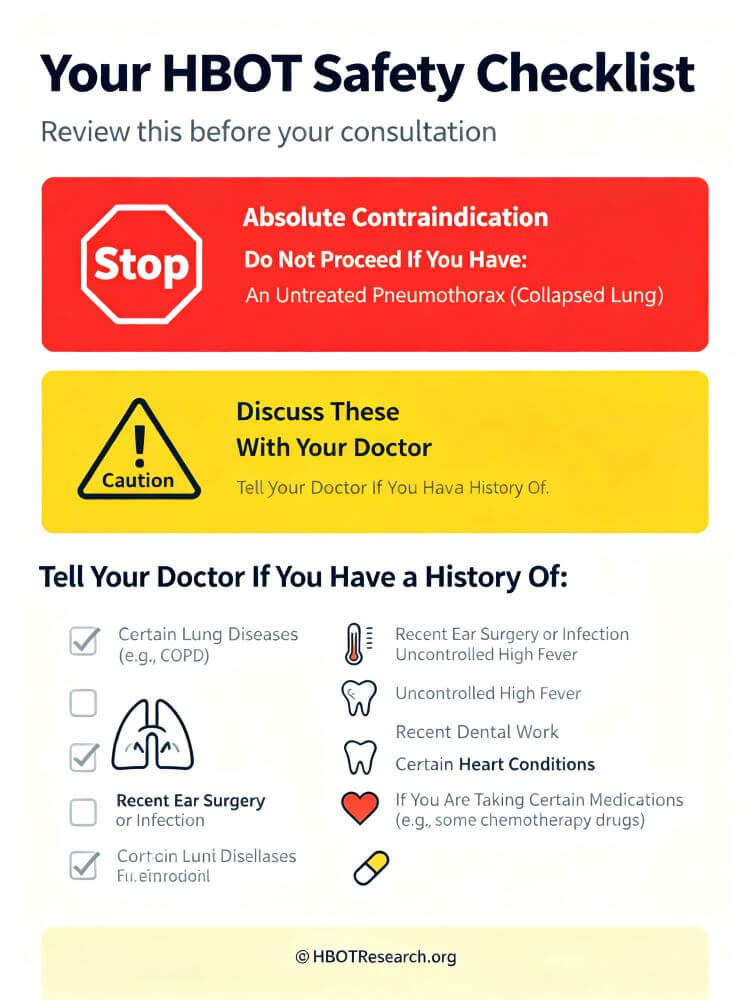
Create a complete medical picture by sharing:
- All current medications and supplements
- Any respiratory conditions or breathing difficulties
- Recent surgeries, especially ear or chest procedures
- Current cold, flu, or sinus congestion
- History of seizures
- Recent dental work or ongoing dental issues
- Pregnancy or possibility of pregnancy
- Claustrophobia or anxiety disorders
During the Treatment: Communication is Key
Your safety depends on open communication with your HBOT team. Report immediately:
- Any ear, sinus, or tooth pain
- Difficulty breathing or chest discomfort
- Vision changes or eye irritation
- Nausea or dizziness
- Unusual anxiety or panic feelings
“Should I just tough it out if I feel uncomfortable?” Absolutely not. Your technician can adjust the treatment, provide coaching, or stop the session if needed. There’s no benefit to enduring unnecessary discomfort.
Bottom Line
HBOT remains one of the safest medical procedures available when performed by trained professionals in accredited facilities. The vast majority of patients complete their treatment courses with minimal or no side effects. Those who do experience side effects typically find them mild and manageable.
Key points to remember:
- Most side effects are temporary and resolve quickly
- Serious complications are extremely rare
- Your medical team is trained to prevent and manage any issues
- Open communication with your treatment team is essential
Have more questions about the side effects of HBOT? Talk to a certified hyperbaric medicine specialist. They can address your specific concerns and help you make an informed decision about your treatment.
References
- [1] Mayo Clinic – “Hyperbaric oxygen therapy” – 2023
- [2] Johns Hopkins Medicine – “Hyperbaric Oxygen Therapy” – 2023
- [3] Undersea and Hyperbaric Medical Society – “HBOT Indications” – 2023
- [4] Hadanny, A., & Efrati, S. – “The Hyperoxic-Hypoxic Paradox” – Biomolecules, 2020
- [5] Gesell, L.B. (Ed.) – “Hyperbaric Oxygen Therapy Indications” – Undersea and Hyperbaric Medical Society, 2023
- [6] McMonnies, C.W. – “Hyperbaric oxygen therapy and the possibility of ocular complications or contraindications” – Clinical and Experimental Optometry, 2015
- [7] Camporesi, E.M. – “Side effects of hyperbaric oxygen therapy” – Undersea & Hyperbaric Medicine, 2014
- [8] Heyboer, M., et al. – “Hyperbaric Oxygen Therapy: Side Effects Defined and Quantified” – Advances in Wound Care, 2017
- [9] Plafki, C., et al. – “Complications and side effects of hyperbaric oxygen therapy” – Aviation, Space, and Environmental Medicine, 2000
- [10] Weaver, L.K. – “Hyperbaric Oxygen Therapy for Carbon Monoxide Poisoning” – Undersea & Hyperbaric Medicine, 2014
- [11] Stevens, S.L., et al. – “The effect of hyperbaric oxygen on blood glucose levels in patients with diabetes mellitus” – Undersea & Hyperbaric Medicine, 2015
- [12] Smerz, R.W. – “Incidence of oxygen toxicity during the treatment of dysbarism” – Undersea & Hyperbaric Medicine, 2004
- [13] Thom, S.R. – “Hyperbaric oxygen: its mechanisms and efficacy” – Plastic and Reconstructive Surgery, 2011
